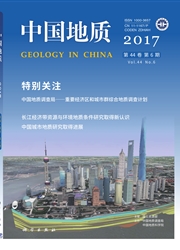

 中文摘要:
中文摘要:
八大关铜钼矿床是内蒙古德尔布干成矿带中段的一个典型斑岩型矿床,绢英岩化、青磐岩化等蚀变分带明显,矿体呈条带状赋存于印支期石英闪长岩中。笔者通过运用Re-Os同位素年代学、元素地球化学以及硫同位素等测试手段,初步分析了该矿床的成矿过程。辉钼矿Re-Os同位素加权平均模式年龄为(226.7±2.4) Ma,表明该矿床形成于晚三叠世早期;元素地球化学分析显示含矿岩体属于中钾含量的钙碱性岩石系列,为I型花岗岩,产于火山弧构造环境,具有活动板块边缘的特征,矿化过程中,成矿母岩的稀土元素总量逐渐降低,轻重稀土发生明显分异;金属硫化物的δ34S值介于+0.5‰~+4.8‰,具有幔源硫的特征。综合分析认为八大关铜钼矿床形成于晚三叠世,蒙古-鄂霍茨克洋向南俯冲过程中,深部岩浆活动带来了大量成矿物质,洋壳部分熔融侵位到额尔古纳地块之上,随热液流体迁移的Cu、Mo等元素与源自地幔的硫相结合,最终富集成矿。
 英文摘要:
英文摘要:
Located in the middle of Derbugan metallogenic belt in Inner Mongolia, the Badaguan copper-molybdenum deposit is a typical porphyry deposit with obvious phyllic and propylitic alteration zones. The banded orebodies occur in Triassic quartz diorite. By such means as Re-Os isotope geochronology, element geochemistry and sulfur isotope geochemistry, the authors preliminarily analyzed the ore-forming process of the deposit. Re-Os dating of molybdenite gave a weighted average model age of (226.7 ± 2.4) Ma, implying that the deposit was formed in the early Late Triassic. Element geochemical analysis shows that the ore-bearing rocks were I-type granites and belonged to calc-alkaline rock series with moderate content of potassium, which were produced in a volcanic arc environment with characteristic active plate edges. During the ore-forming process, ΣREE in ore-bearing rock gradually decreased, and the ratio of LREE to HREE became higher. The δ 34S values of metallic sulfides range from +0.5‰ to+4.8‰, suggesting mantle sulfur origin. Based on a comprehensive analysis, the authors hold that the Badaguan copper-molybdenum deposit was formed in the Late Triassic. During the southward subduction of Mongolia-Okhotsk Ocean plate, magmatic activity at the depth brought lots of ore-forming materials, and partially melted oceanic plate was emplaced above Ergun block. Cu, Mo and other elements migrated with the hydrothermal fluids and combined with sulfur from the mantle, eventually resulting in enrichment and mineralization.
 同期刊论文项目
同期刊论文项目
 同项目期刊论文
同项目期刊论文
 期刊信息
期刊信息
